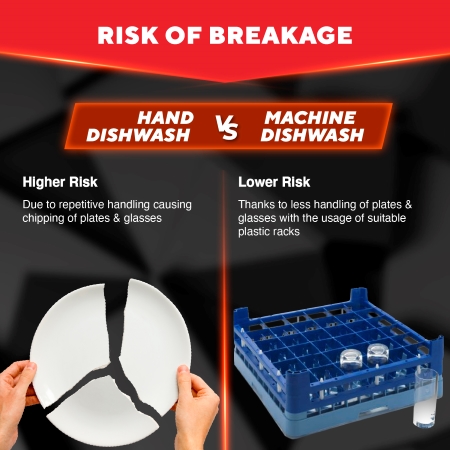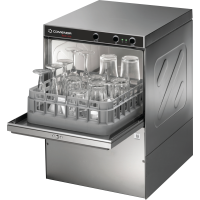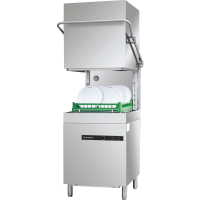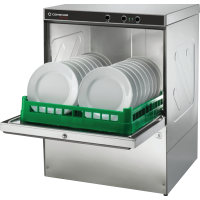5 Compelling Reasons to Switch from Handwashing to a Commercial Dishwasher in Your F&B Business

Hand Dishwash vs. Machine Dishwash: The Smart Choice for F&B Businesses
Running a successful food and beverage (F&B) business is not just about serving delicious meals; it's about ensuring operational efficiency, hygiene, and cost-effectiveness in the kitchen. A key area where businesses can make improvements is dishwashing. Many F&B operations still rely on hand dishwashing, but commercial dishwashers, such as those from the Comenda brand, offer significant benefits. In this post, we’ll explore five compelling reasons why switching to a Comenda commercial dishwasher can streamline your operations, reduce costs, and enhance hygiene standards.
1. The Cost Efficiency of Commercial Dishwashers
Handwashing: Hidden Expenses
Handwashing dishes may appear to be an inexpensive option, but the reality is different. It requires 30% more labor, increases water usage, and leads to higher detergent costs. Over time, these hidden expenses can take a toll on your F&B business's profitability.
Commercial Dishwashers: Cost-Effective Solution
A commercial dishwasher can cost as little as RM23.75/day, making it a highly cost-effective solution. By significantly reducing labor, water, and detergent consumption, businesses can quickly see a return on their investment. This cost-effective dishwashing solution is ideal for any F&B business looking to optimize its kitchen operations.

Cost Comparison: Handwashing vs Commercial Dishwasher
2. Reducing the Risk of Breakage
Handwashing: Higher Risk of Damage
Handwashing requires frequent handling of plates and glasses, increasing the risk of chipping or breaking, which leads to additional replacement costs.
Machine Dishwashing: Safer and More Reliable
With a commercial dishwasher, the risk of breakage is minimized thanks to the use of plastic racks designed to securely hold items. This not only reduces breakages but also lowers overall costs, making it the smarter choice for restaurant dishwashing.
 Breakage Risk: Handwashing vs Machine Dishwashing
Breakage Risk: Handwashing vs Machine Dishwashing
3. Meeting Hygiene and Health Standards in F&B
Handwashing: Inconsistent Hygiene Practices
Handwashing can rarely meet governmental hygiene standards due to inconsistent water temperatures and improper drying techniques. The frequent use of the same towel for drying dishes can also lead to bacterial growth, posing a health risk to customers.
Commercial Dishwashers: Superior Hygiene Control
Comenda dishwashers adhere to strict hygiene standards by operating at optimal water temperatures to kill germs. The high-temperature rinse cycle at 85°C ensures that dishes are sanitized thoroughly, while the self-drying process eliminates the need for towels, improving overall kitchen cleanliness and compliance with F&B kitchen hygiene standards.

Hygiene Standards: Handwashing vs Commercial Dishwasher
4. Improving Kitchen Layout and Organization
Handwashing: Messy and Disorganized Kitchens
Kitchens that rely on handwashing often face disorganization and clutter, with dirty dishes piling up, creating a mess and potentially leading to poor hygiene practices.
Machine Dishwashing: A Tidy and Efficient Solution
With a commercial dishwasher, your kitchen remains tidy and efficient. Dirty and clean dishes are organized systematically, reducing clutter and making it easier for staff to maintain a hygienic, well-organized workspace.
 Kitchen Organization: Handwashing vs Dishwasher
Kitchen Organization: Handwashing vs Dishwasher
5. Reducing Bacterial Growth in Your F&B Kitchen
Handwashing: A Breeding Ground for Bacteria
Low water temperatures during handwashing make it difficult to eliminate bacteria completely. Additionally, towels used for drying dishes can harbor germs, increasing the risk of contamination and making the drying process slow and unpredictable.
Machine Dishwashing: Ensuring Sanitary Conditions
Commercial dishwashers operate at ideal temperatures for removing bacteria. Rinsing dishes at 85°C not only kills germs but also speeds up the drying process through evaporation, supported by rinse aids. This fast, hygienic process minimizes the risk of bacterial growth, ensuring a cleaner and safer kitchen.

Bacterial Growth: Handwashing vs Machine Dishwashing
Why Your F&B Business Should Invest in a Commercial Dishwasher
For any F&B business aiming to boost efficiency, save costs, and maintain impeccable hygiene standards, switching from handwashing to a Comenda commercial dishwasher is a game-changing move. From reducing the risk of breakages to improving kitchen organization and eliminating harmful bacteria, a dishwasher is a valuable investment that pays off in numerous ways.
Ready to upgrade your dishwashing process? Contact us to learn how Comenda dishwashers can elevate your F&B kitchen to new levels of efficiency and hygiene.








